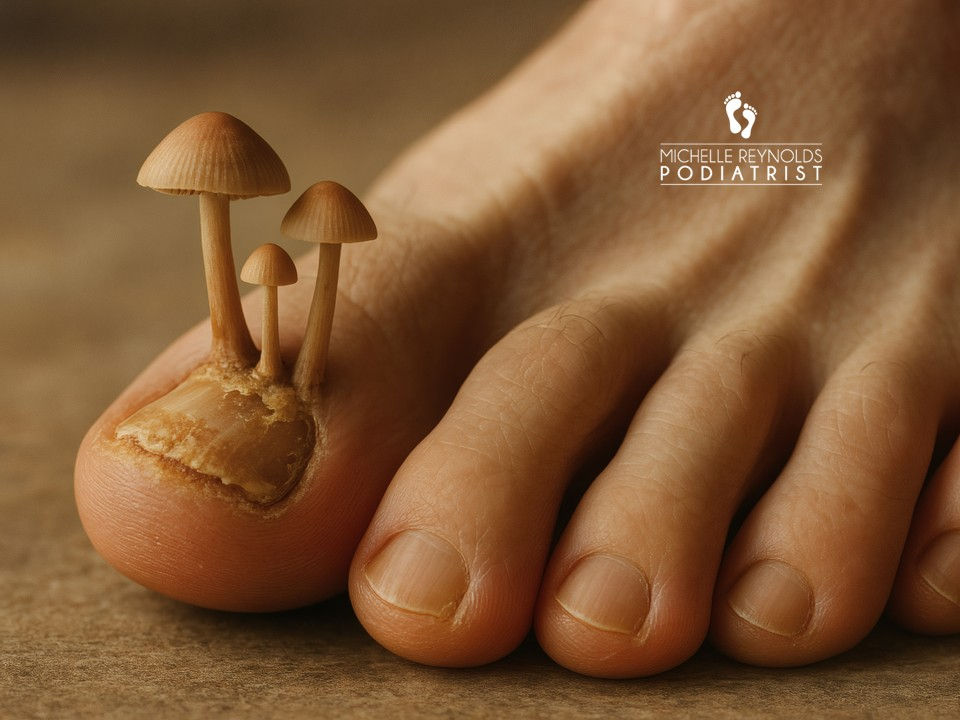Why does my toenail fungus keep coming back?
- Michelle Reynolds

- Jul 26
- 4 min read
Understanding Recurrence of Toenail Infection
If you’ve ever battled toenail fungus—medically known as onychomycosis—you know it can be a stubborn and frustrating condition. Many patients are relieved when treatment begins to work, only to be disappointed when the infection returns. So why does onychomycosis often recur, and what can be done to stop the cycle?

What Is Onychomycosis?
Onychomycosis is a fungal infection of the toenails (or fingernails, though toes are far more commonly affected). It often causes the nails to become thickened, discoloured (yellow, white, or brown), brittle, or crumbly. In some cases, the nail can lift off the nail bed or emit a mild musty odour. Most fungal nail infection is caused by organisms called dermatophytes.
The fungus thrives in warm, moist environments—like sweaty socks, communal showers, and shoes—and can infect anyone, although it's more common as we age or in people with diabetes or compromised immune systems.
Read more about fungal nail infection in our blog here.
Treatment Options
Treating onychomycosis isn’t always straightforward. Note, not all discoloured, thickened or crumbly nails are caused by fungal infections and it is important to have a diagnostic test before treatment is started. There are several treatment approaches:
Topical antifungal medications – These are applied directly to the nail, but they often require prolonged use and often do not penetrate deep enough in and under the nail to eliminate the infection fully.
Oral antifungal medications – These tend to be more effective, as they treat the infection from the inside out, but they require a prescription and regular monitoring for potential side effects.
Laser therapy – Some clinics offer laser treatment to target fungal cells in the nail, though this method is still considered experimental, there is limited research on this topic so evidence of the effectiveness of laser treatment is scarce.
Nail debridement – Trimming, thinning, or removing part of the infected nail can help topical treatments work more effectively.
Clearanail – this is a novel device which makes small holes in the nail allowing topical treatments to better reach the site of the fungal infection (the infection is often on the underside of the nail). Read more here.

Why Does Toenail Fungus Keep Coming Back?
Unfortunately, onychomycosis has a high recurrence rate. Studies show that recurrence can happen in up to 20-25% of cases within the first year after treatment—and the rate increases the longer you follow up. Up to 87% are said to recur within a few years.
So why is it so persistent?
The Nail Grows Slowly: Toenails especially grow slowly—about 1 mm per month—so even after successful treatment, full nail recovery can take 12–18 months. During that time, the nail is still vulnerable to reinfection.
Environmental Re-exposure: Fungi love damp, warm spaces. If you continue to wear old shoes, use contaminated nail tools, or walk barefoot in public showers, you can easily become re-infected—even after effective treatment.
Tinea Pedis (Athlete’s Foot): This is a big one. Onychomycosis and tinea pedis (commonly known as athlete’s foot) are often caused by the same types of fungi. If you have athlete’s foot and don’t treat it, the fungus can spread to the nails and vice versa. This is a major reason why recurrence happens.
Incomplete Treatment: Some people stop treatment too early. Fungal infections need consistent and prolonged treatment to fully eradicate, even if signs/symptoms appear to improve quickly.
Underlying Health Conditions: Conditions like diabetes, poor circulation, or a weakened immune system can increase vulnerability to fungal infections and increase the risk of recurrence.
Damaged Nails: Rough, cracked, brittle nails are more vulnerable to fungal infection. Smooth healthy nails are a better barrier. If a nail is damaged or diseased, such as a nail affected by psoriasis, the fungus can get in and under the nail more easily.
Prevention: Your Best Defence
Since onychomycosis is so persistent, prevention is just as important as treatment. Here are some essential tips to reduce your risk of reinfection:
Treat athlete’s foot promptly – If you have signs of fungal skin infection on your feet, use an over-the-counter antifungal cream and keep the area dry. Click here for more information about fungal skin infection.
Do other people in your household have fungal infection? Check everyone at home is treating their skin and nail infections otherwise it will easily and repeatedly spread from person to person.
Keep feet clean and dry – Wash your feet daily. Dry between your toes after showers, and change socks daily—more often if your feet sweat a lot.
Use antifungal shoe sprays – These help control moisture and fungal growth in your shoes and socks.
Disinfect nail tools – Always clean clippers, files, and any other tools before use. Do not share nail clippers with anyone else in the household.
Avoid walking barefoot in public places – Pools, locker rooms, and communal showers are common breeding grounds for fungi.
Replace old footwear – Fungus can live in shoes even after treatment, so consider disinfecting or replacing them after an infection.

Final Thoughts
Onychomycosis can be a long-term nuisance, but understanding why it recurs can help you take the steps needed to keep it at bay. If you’ve struggled with repeated infections, speak with your podiatrist. A comprehensive plan that includes both treatment and long-term prevention is your best bet for keeping your nails healthy and fungus-free.
Here at Michelle Reynolds Podiatry we can advise you on measures to take to help avoid reinfection.
To take your first step towards fungus free feet get in touch today by calling 0161 427 4937 or email info@mrpodiatrist.co.uk

